Affiliate disclosure: This post may contain affiliate links. Please see our Privacy Policy.
Canning beef stew is a great way to put up nutritious meals in a jar right on your pantry shelf.
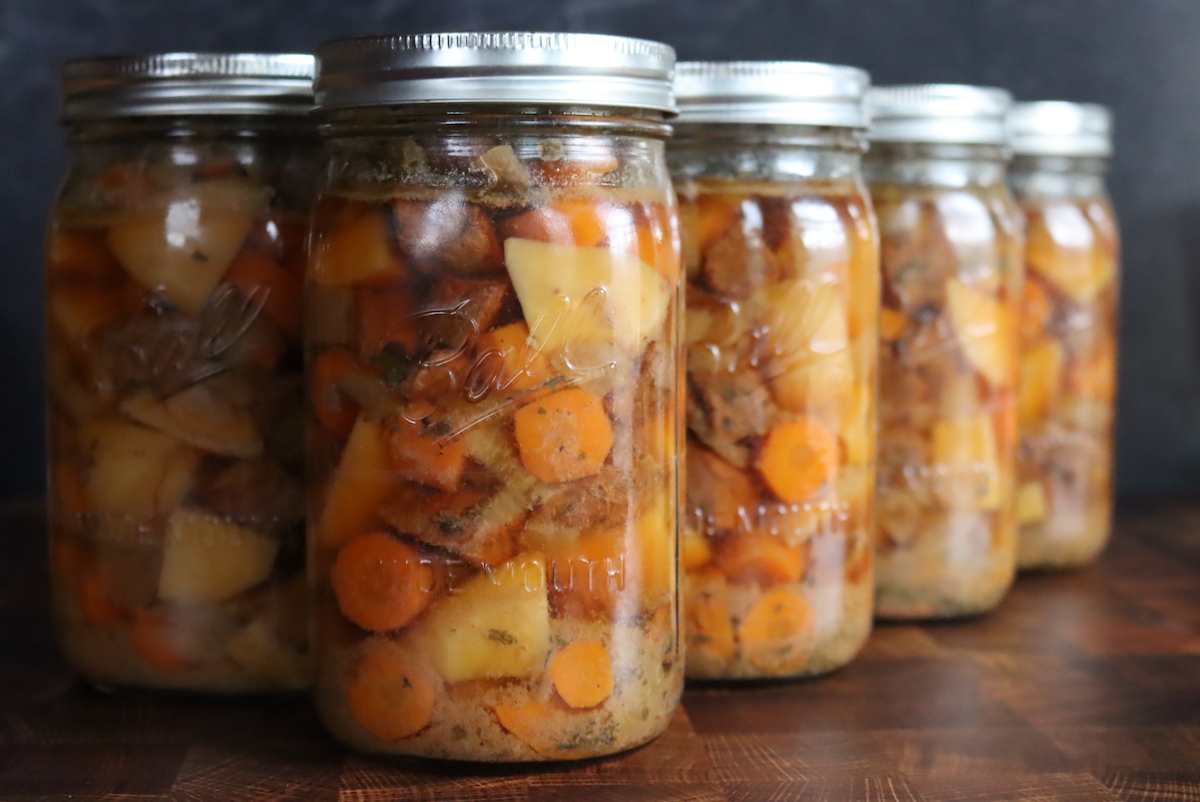
Table of Contents
Quick and easy weeknight meals are all about planning ahead. Sometimes that means meal planning and prep earlier in the week, but it can also mean canning meals in jars for a nutritious homemade meal within easy reach in the pantry.
This past year ordered a side of beef from a local farm and we didn’t have quite enough freezer space to store both the beef and our home garden produce. It was actually a blessing in disguise, and I discovered how easy canning beef really is.
Once I had those ingredients on the shelf, I started looking into soup canning recipes because while home-canned ingredients are wonderful and versatile, home-canned meals are even better.
Home-canned beef stew was the obvious first choice, and it’s absolutely delicious!
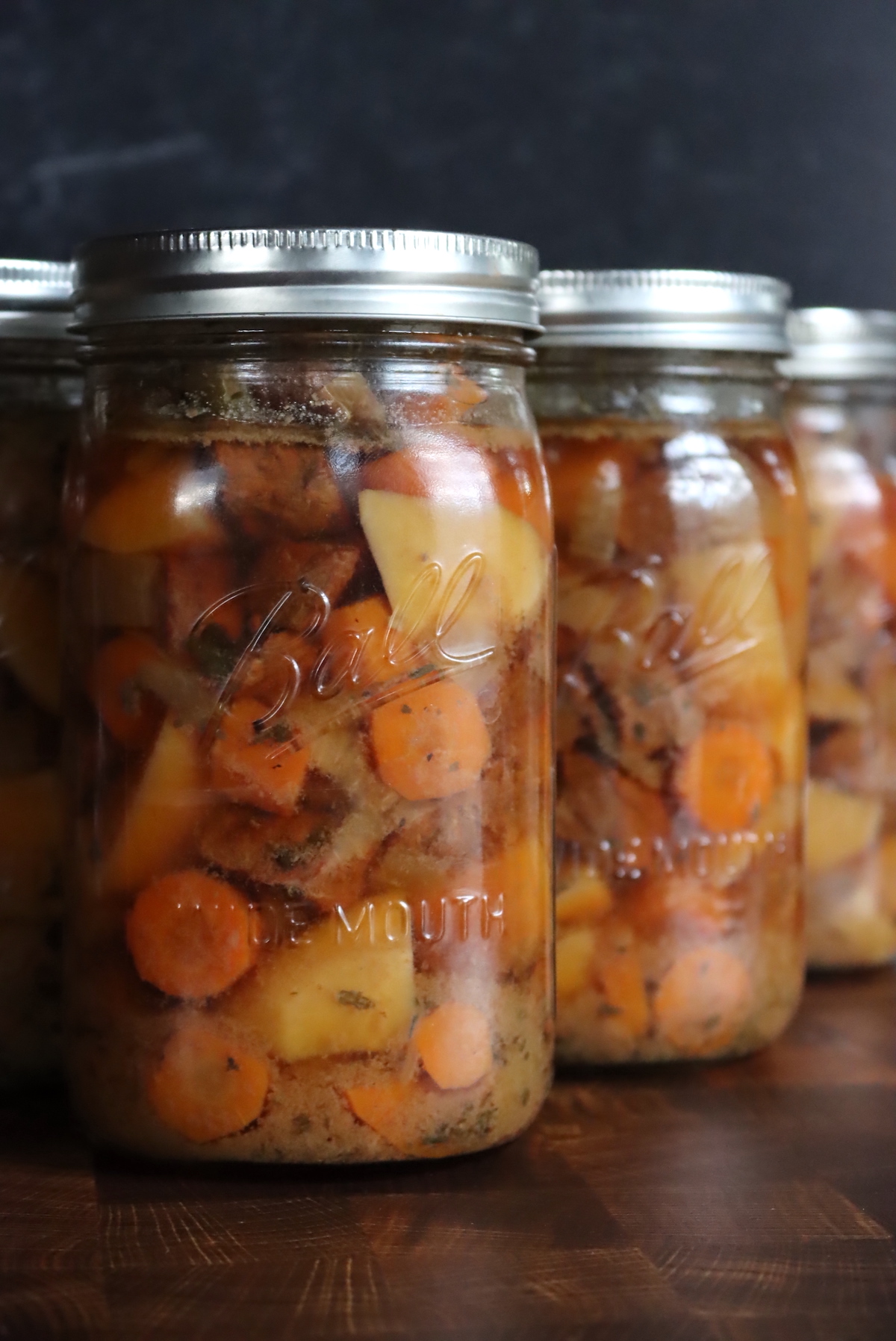
Ingredients for Canning Beef Stew
The canning books all have very similar beef stew recipes, and for the most part they only vary slightly. Some include tomatoes, some don’t. Others include celery instead.
I’m using the “Beef Stew with Vegetables” recipe from The Ball Complete Book of Home Preserving. The only change I made for my family is omitting the celery, as we just don’t like celery.
It’s perfectly fine to omit a vegetable, so long as you don’t add others to make up the difference. Just include a bit more broth in the jars, and still divide all the ingredients across the same number of jars.
The recipe includes:
- 4 to 5 lbs stewing beef, cut into 1 to 1 1/2 inch cubes
- Olive oil to brown meat
- 12 cups potatoes, peeled and cut into 1” chunks, or about 5 pounds potatoes as purchased, about 4 pounds when peeled, trimmed & prepared
- 8 cups carrots, sliced into 1/2 inch rounds, or 2 1/2 lbs prepared (peeled/chopped), from 3 lbs as purchased
- 3 cups onions, peeled and chopped into 1/2 inch pieces, or 1 lb prepared from 1 1/4 lbs as purchased or 2 medium onions
- 3 cups celery, chopped, from about 1 pound prepared or 1 small celery head
- 12 cups beef stock, homemade or store-bought, plus more to fill if necessary
- 4 1/2 tsp salt, optional, adjust to taste (not required for preservation, only flavor)
- 1 tsp dried thyme, optional, adjust to taste
- 1/2 tsp black pepper, optional, adjust to taste
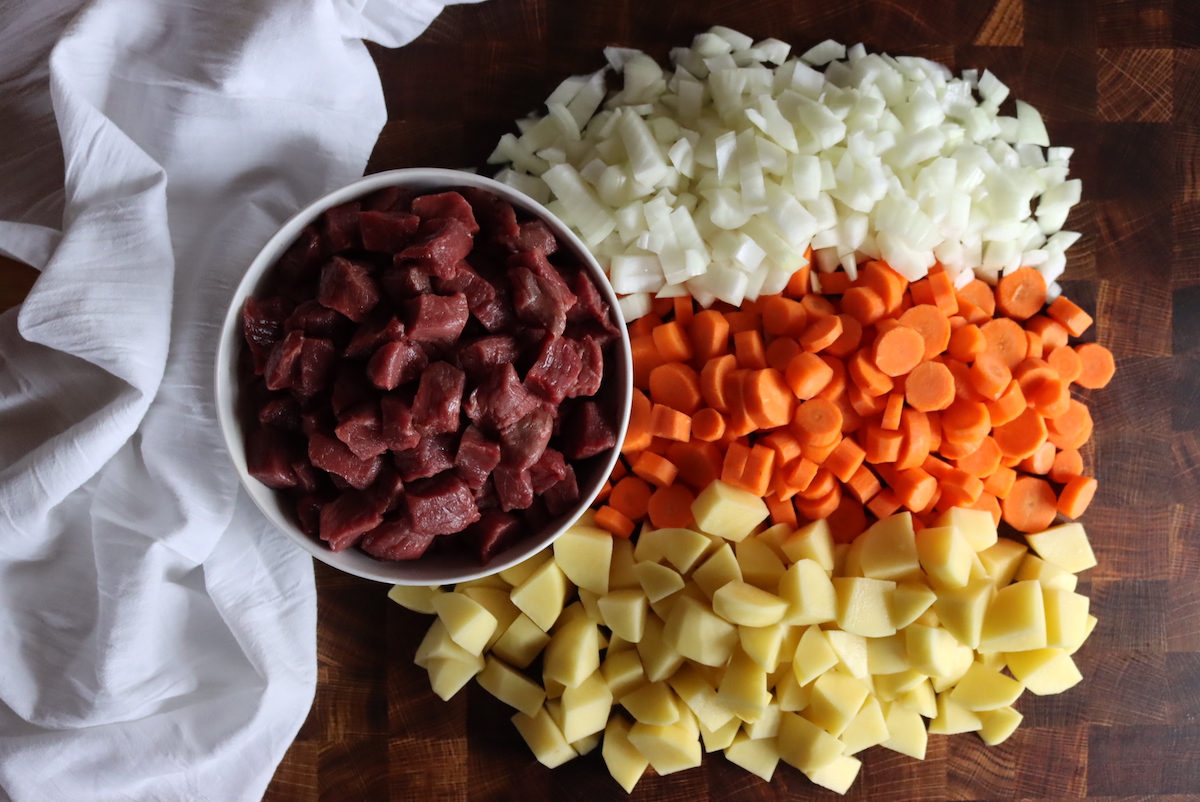
Canning Beef Stew
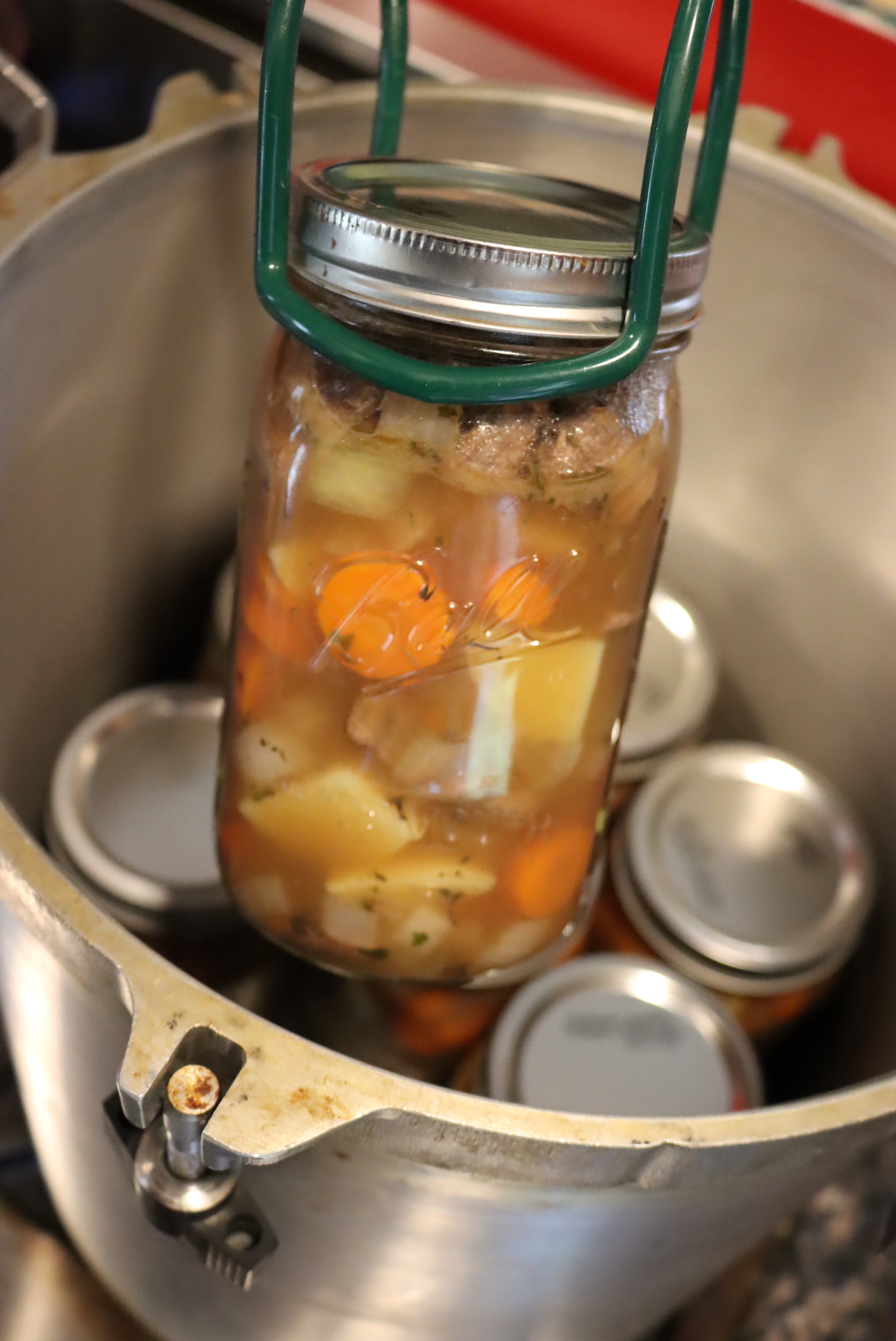
Altitude Adjustments for Canning Beef Stew
While the canning time remains constant in pressure canning, the pressure used varies slightly based on altitude.
At sea level, you use 11 pounds pressure in a dial gauge pressure canner (like presto pressure canners) and 10 pounds in a weighted gauge (like All American Brand). Beyond that, the altitude adjustments for each type of canner are below.
Dial Gauge Canners:
- 0 to 2,000 feet in elevation use 11 pounds pressure
- 2,001 to 4,000 feet in elevation use 12 pounds pressure
- 4,001 to 6,000 feet in elevation use 13 pounds pressure
- 6,001 to 8,000 feet in elevation use 14 pounds pressure
Weighted Gauge Canners:
- 0 to 1,000 Feet in elevation use 10 pounds pressure
- Above 1,000 Feet in elevation use 15 pounds pressure
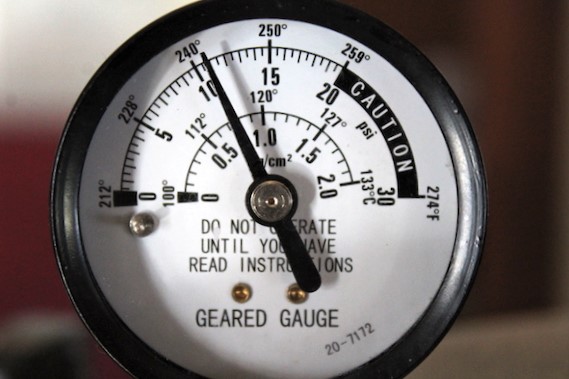
Variations in Beef Stew Canning Recipes
The same basic recipe for canning beef stew can be found in a number of different pressure canning books. It’s the same amount of beef, potatoes, carrots, and onions almost every time.
What changes is the seasonings, and occasionally other vegetables are added like celery or tomatoes. Sometimes the potatoes are reduced to make a bit of space for the other vegetables, but that’s it.
This beef stew canning recipe is a classic, and it comes from The Ball Complete Book of Home Preserving. Everyone’s tastes are a little bit different, so I’ll take you through some other tested recipe variations.
The Homestead Canning Cookbook uses the exact same recipe but opts for 1/2 tsp of summer savory in place of thyme.
Diane Devereaux’s Pressure Canning Book has reduced the chopped potatoes to 10 cups, and the celery to 2 cups. She then adds in 3 cups of chopped Roma tomatoes. She adds considerably more seasoning, including:
- 1 Tbsp dried parsley
- 1 Tbsp dried oregano
- 1/2 Tbsp celery seeds
- 1 tsp ground coriander
- 1 tsp dried thyme
- 1 tsp dried basil
- 1/2 tsp black pepper
- 4 1/2 tsp salt
Personally, I think her recipe takes things too much into an Italian flavor direction, with tomatoes, oregano, basil, and parsley. If that sounds good to you, go for it!
The yield is still 7 quarts, and the canning times/pressures are the same.
Angi Schneider’s Pressure Canning Book has by far the most creative beef stew canning recipe I’ve found yet, and most of the recipes in her book are really unique and delicious.
She goes with a variation that uses sweet potatoes and mushrooms. Her recipe is a bit smaller and makes 4 one-quart jars.
It includes:
- 3 lbs stew beef
- 2 tbsp olive oil (for browning meat)
- 1/2 cup red wine
- 6 cups beef stock
- 2 tbsp tomato paste
- 2 cups chopped onions
- 1 cup chopped carrots
- 6 cloves garlic, chopped
- 1/2 lb mushrooms, sliced
- 3 cups peeled and diced sweet potato
- 1/2 tsp dried thyme
- 2 tsp salt
- 1 tsp pepper
- 4 bay leaves
Instructions and canning times are the same as the generic beef stew canning recipe. The yield as I mentioned is only 4 quarts, but you can double the recipe to fill your canner with 7 quarts (and then have a bit leftover for lunch).
Other Alterations
Beyond these specifically tested beef stew canning recipes, there are a few changes you can safely make to pressure canning recipes in general.
Feel free to adjust the seasonings slightly as it suits your taste, so long as you use only modest amounts of dry seasonings. You can also add 1/4 to 1/2 cup Worcestershire sauce for flavor without affecting canning safety (in that case, reduce the salt by 1-2 teaspoons).
Personally, I don’t like celery, so I skip it and I prefer beef stew without tomatoes. Keep in mind that you can omit ingredients or reduce the quantity, but don’t increase ingredients or substitute other vegetables instead.
That means you can skip the celery, but you can’t add in extra onions to make up the difference.
Serving Home Canned Beef Stew
Since flour and other thickeners are not approved for canning, this beef stew is a bit on the thin side right out of the jar. If you like a thickened beef stew, you might want to strain out the broth and thicken it, as I do.
I like to make a roux with a bit of butter and flour, then add the stock in to thicken it into a rich gravy-like stew, to me that tastes better than cornstarch and it works better than just flour alone.
You can also just heat and serve as is, if that’s your preference. (Or in a pinch, eat it right out of the jar cold if you’re traveling or out on a job site for your meal.)
Beef Canning Recipes
Looking for more ways to can beef at home?
- Canning Beef (Chunks, Steak, Roasts, Ground or Hamburgers)
- Canning Sloppy Joes
- Chili Con Carne
- Beef Burgundy (Julia Child’s Recipe)
- Beef Pot Roast in a Jar
- Beef Stroganoff
- Beef Tips and Gravy
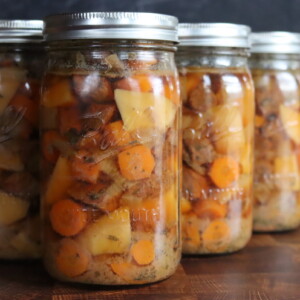
Canning Beef Stew
Ingredients
- 4 to 5 lbs stewing beef, cut into 1 to 1 1/2 inch cubes
- Olive oil to brown meat
- 12 cups potatoes, peeled and cut into 1” chunks, or about 5 pounds potatoes as purchased, about 4 pounds when peeled, trimmed & prepared
- 8 cups carrots, sliced into 1/2 inch rounds, or 2 1/2 lbs prepared (peeled/chopped), from 3 lbs as purchased
- 3 cups onions, peeled and chopped into 1/2 inch pieces, or 1 lb prepared from 1 1/4 lbs as purchased or 2 medium onions
- 3 cups celery, chopped, from about 1 pound prepared or 1 small celery head
- 12 cups beef stock, homemade or store-bought, plus more to fill if nessisary
- 4 1/2 tsp salt, optional, adjust to taste (not required for preservation, only flavor)
- 1 tsp dried thyme, optional, adjust to taste
- 1/2 tsp black pepper, optional, adjust to taste
Instructions
- Before beginning, prepare a pressure canner for hot pack canning by adding several inches of water to the bottom and bringing it up to a simmer (around 180 degrees F). Follow the manufacturer’s instructions for your own pressure canner model as they may differ. Prepare jars and rings as well.
- Brown the beef in a small amount of olive oil. Work in batches and don’t crowd the pan. It should be nicely browned on the outside, but not cooked through. Do not use flour to brown the meat!
- Bring beef broth to a simmer in another pan. Add the browned meat, vegetables, salt, and seasonings, then return to a simmer. As soon as it begins simmering, prepare to pack the jars.
- Use a slotted spoon to scoop out the beef and vegetables into canning jars. Evenly distribute the solids across all the jars, leaving 1” headspace.
- Ladle the simmering beef stock over the top of the solids, still maintaining 1” headspace.
- Wipe rims and attach 2 part canning lids to finger tight. Use a jar lifter to place the jars in your pressure canner, and then close the lid.
- Allow the steam to vent for 10 minutes, then seal the pressure canner and bring it up to temperature.
- Process the jars at the appropriate pressure for your altitude (see notes) for 75 minutes for pints and 90 minutes for quarts.
- When the canning time is complete, turn off the heat and allow the canner to cool naturally back to room temperature before opening the canner. (Do not open early, or attempt to speed cool the canner!)
- Check jar seals once cool. Properly canned and sealed jars should maintain peak quality on the pantry shelf for 12-18 months. Store any unsealed jars in the refrigerator for immediate use.
Notes
Dial Gauge Canners:
- 0 to 2,000 feet in elevation use 11 pounds pressure
- 2,001 to 4,000 feet in elevation use 12 pounds pressure
- 4,001 to 6,000 feet in elevation use 13 pounds pressure
- 6,001 to 8,000 feet in elevation use 14 pounds pressure
Weighted Gauge Canners:
- 0 to 1,000 Feet in elevation use 10 pounds pressure
- Above 1,000 Feet in elevation use 15 pounds pressure
Soup Canning Recipes
Beef stew may be popular, but it’s not the only soup canning recipe out there!
- Classic Vegetable Soup
- Split Pea Soup
- Carrot Soup
- Potato Leek Soup
- Sausage, Potato, and Kale Soup
- Sausage and Bean Soup
- Classic Chicken Soup
Pressure Canning Recipes
Stock your pantry with these pressure canning recipes:
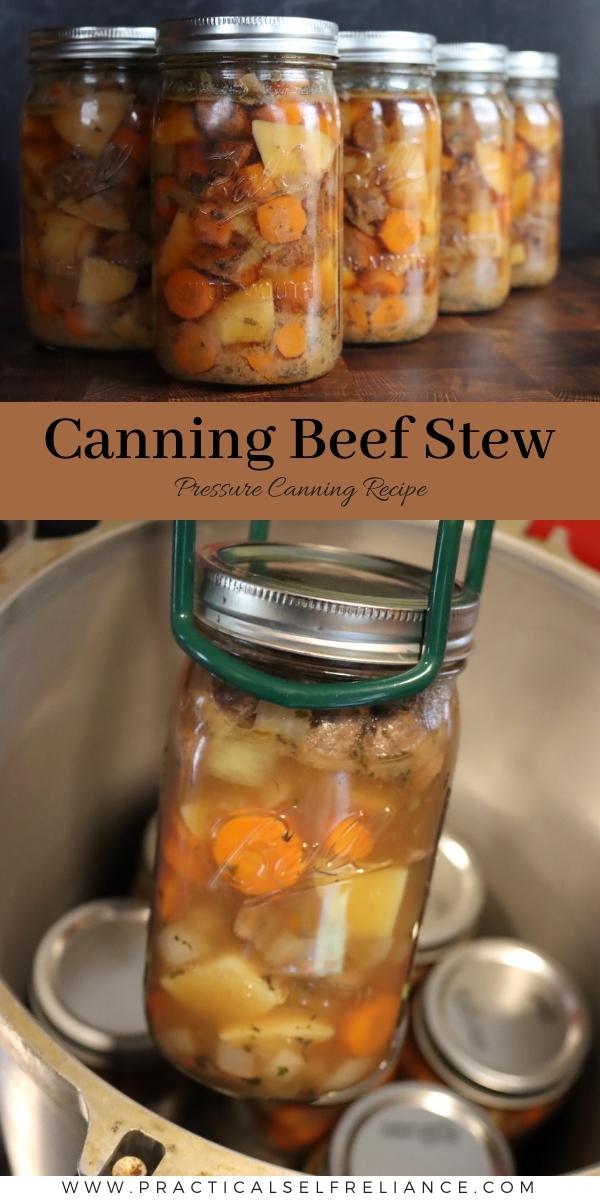
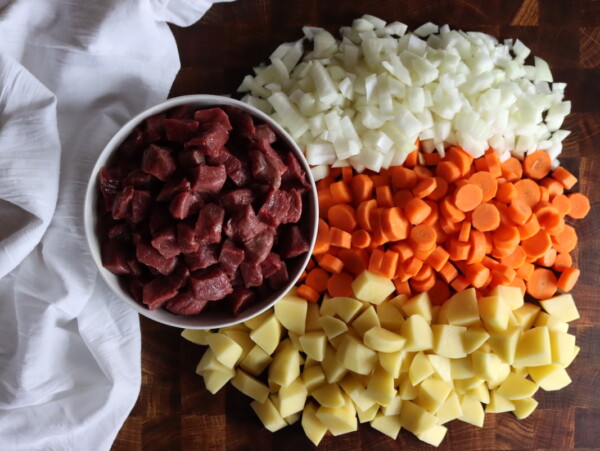
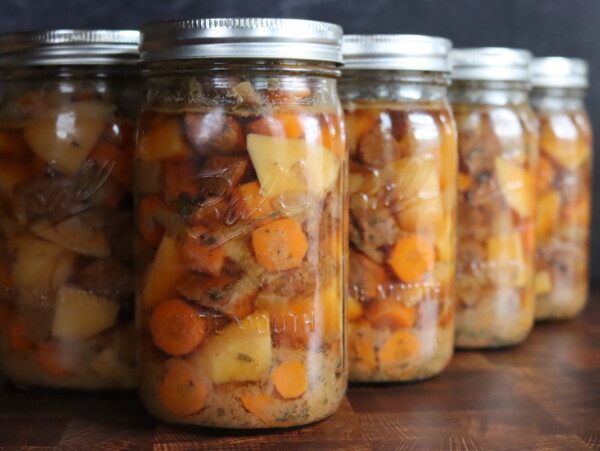
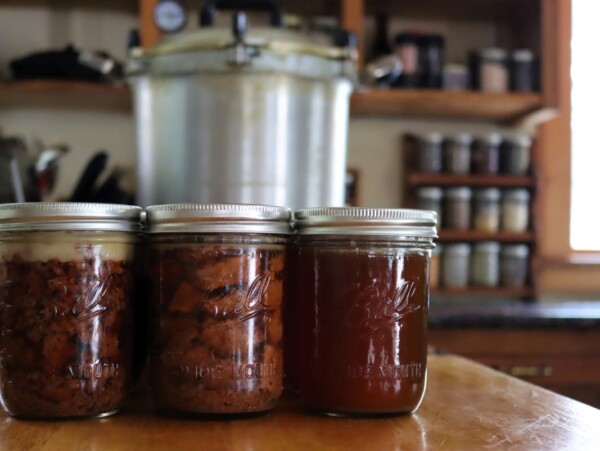
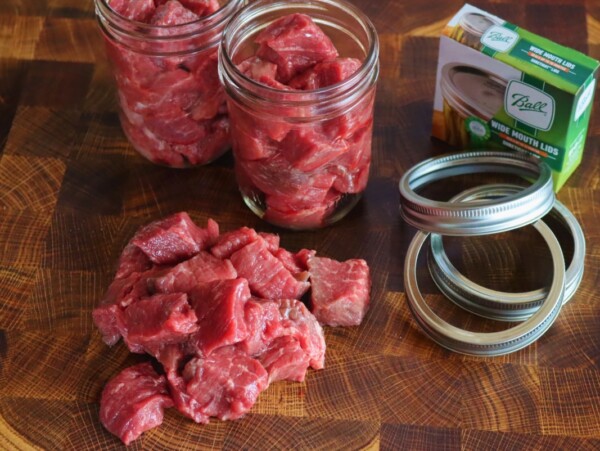










I’ve made this recipe several times now. The consistency and quantity are on the mark. I receive many compliments about the flavor by adding a bit of red wine. Thanks for this!
Wonderful!
Can your Pot Roast in a Jar canning recipe be doubled or tripled?
Thanks
Yes. Any pressure canning recipe can be doubled or tripped so long as you have the capacity in your canner. The only canning recipes that don’t do well when increased are jam, jelly and preserve recipes that need to heat evenly to get the pectin to set.
Howdy,
I have been using mushrooms in soups and stews. Are mushrooms cannable?
Are you asking if you can process them in a water bath canner or pressure canner?
You mentioned we could not substitute an onion for a carrot. Why is that? I like making an 8 can soup with assorted ingredients and wanted to do a bulk batch now I’m thinking it may not be safe? Any help is appreciated as I’ve only pressure canned chicken so far. Thank you!
Increasing low acidity vegetables can dilute the acidity of the final product and can cause botulism.
I made seven quarts of this soup it is fabulous
So glad you enjoyed it.
I am canning this right now, except I replaced the stew meat with 5lbs of ground beef, and I somehow got a full extra quart. I didn’t precisely measure out all the veggies, so maybe I accidentally put too much? I’m assuming it’ll still be safe if I just process it the same way.
That should still be fine to process even with an extra quart, just make sure your jars aren’t packed too tightly and that you have plenty of liquid in each jar. When canning with ground beef, you have to brown the ground meat before loading it into the jars so that it doesn’t form into a dense loaf in there as it cooks. Provided you browned the meat and processed the jars the appropriate amount of time, an extra jar happens some times and is fine. Yields can vary a bit in canning, and that’s normal.
I have the same book but the recipe on page 407 for Beef Stew with Vegetables does not mention beef stock.
It uses water instead, but that’s not great for flavor. You are allowed to trade out broth/stock/water/bullion/etc in canning recipes. You can use any liquid you like here, be it water, beef stock, veggie stock, chicken or mushroom stock…whatever. It’s all fine, so long as it’s just water based.
Great recipe and easy to follow. In some of the jars some pieces of food are out of the liquid will that be ok? The jars look like the jars in your cover photo though! Thanks!
Yes, that should be fine. You probably experienced a bit of siphoning. This isn’t a problem as long as you haven’t lost more than half of the liquid and the food was processed correctly.
My family doesn’t like onions. Can I use powder onions? If so, how much?
You should be able to do that. I’m not sure if it would affect the flavor or not but it’s worth a try. I would just add in however much you need for the taste or just omit them altogether.
Hello,.my name is Lori. I’m new to canning, and only started just recently. So far I have only canned a bunch of potatoes and boneless chicken. This weekend I will be canning carrots for the first time.
Question on the beef stew….so the beef is browned and the broth is boiled…the actual stew is not cooked through because it will cook in the canner, correct?
Can I just use my own recipe? I just wouldn’t actually cook it, correct? I’m really excited to get some meals-in-a-jar put in my pantry. Thank you for your insight.
It’s really a good idea to use approved and tested recipes especially when you’re new to canning to ensure that your recipe is safe.
Will the taste be altered a worse way if I use homemade chicken broth?
Beef stock is the best but chicken broth will work as well if you don’t have beef stock on hand.
Hello, recently I made a batch of beef stew and put it in the pressure canner. When we put in the mason jars, the veg and meat were adequately covered by water, and we had one inch of headspace. When the pressure canner was done we found out a lot of the water in the cans have escaped, leaving the veg exposed and a greasy jar. Did we over pack it? Was there too much fat? Anyway thanks for any tips
It could have been several different factors. High amounts of fat will sometimes prevent jars from sealing as well as an improper amount of headspace. There can also be siphoning which happens if the temperature change is too sudden.
This was the best written recipe! And so simple. I canned 7 quarts of this today and I love it!
We’re so glad you enjoyed the recipe. Thanks for sharing.
Can you simply bottle this as I don’t have a pressure canner and I don’t know what it is… can I process it in a hot water bath ?
This recipe needs to be processed in a pressure canner. Low acid foods such as meat and most vegetables require pressure canning in order to be safe.
Your recipe does not give any kind of yield that I could find. How many jars does this make?
Please also clarify that ‘hot pack’ must means the items are in hot liquid before being put into the jars.
Or is there a cooking time? If so, I didn’t see that in the recipe, either. (Old eyes?)
Thank you.
There is a recipe card down at the bottom of the post and the yield is included in the image at the top of the recipe card. It is sometimes easy to miss. This recipe makes about 7 quarts or 14 pints. That recipe card also includes the step by step instructions. You want to brown your meat, simmer your broth, and then add the meat, vegetables and seasonings to the broth. Once that mixture reaches a simmer, you will then start packing the jars. The remainder of the cooking will be done during the pressure canning process.